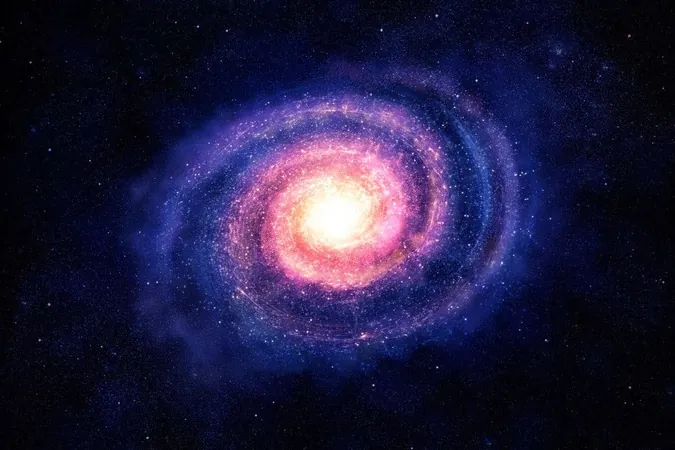
Astonishing Discovery: James Webb Uncovers "Dead" Galaxy Just 700 Million Years After the Big Bang!
2025-04-05
Author: Ming
In a groundbreaking revelation, astronomers utilizing the James Webb Space Telescope (JWST) have unveiled the most distant quiescent galaxy known to date. This astonishing find demonstrates that some massive galaxies ceased forming stars far earlier than previously believed, occurring a mere 700 million years after the Big Bang.
A Galactic Marvel in Deep Space
The newly discovered galaxy, dubbed RUBIES-UDS-QG-z7, was located by the European-led RUBIES survey during JWST's second observation cycle. This remarkable galaxy is packed with over 10 billion solar masses contained within an incredibly small region of just 650 light-years across, making it remarkably dense for its age.
What sets RUBIES-UDS-QG-z7 apart is its quiescent nature, signifying that it had already halted star formation when the Universe was still in its infancy, less than a billion years old. This discovery challenges long-standing theories about the timeline for massive galaxy formation and their subsequent "shutdown".
Andrea Weibel, the lead author of the study and a doctoral student at the University of Geneva, remarked, “The discovery of this galaxy implies that massive quiescent galaxies in the first billion years of the Universe are over 100 times more abundant than any current model has predicted.”
Star Formation Ends Sooner than Anticipated
The study, which has been published in the esteemed Astrophysical Journal, outlines that in standard astrophysical models, galaxies accumulate mass by siphoning gas from the surrounding intergalactic medium and converting it into stars. As the mass increases, this process is expected to accelerate until a phenomenon known as "quenching" halts star formation. However, the recent findings suggest this quenching occurs much faster than previously thought.
Utilizing JWST's cutting-edge infrared instruments, scientists have been able to detect light from incredibly distant galaxies, allowing them to analyze the spectral characteristics of RUBIES-UDS-QG-z7. The data collected from JWST reveals an aging stellar population characterized by an absence of hot, blue stars, leaving behind only older, red stars—an indication that this galaxy had already undergone its stellar life cycle.
A New Perspective on Early Galaxies
Anna de Graaff, principal investigator of the RUBIES program and a postdoctoral researcher at the Max Planck Institute for Astronomy, added, “The discovery of RUBIES-UDS-QG-z7 provides powerful evidence that some massive elliptical galaxies might have had their cores in place just a few hundred million years after the Big Bang.”
This finding poses a significant challenge to existing theoretical models. Until this discovery, the earliest identified quiescent galaxies dated back to 1.2 billion years after the Big Bang (redshift ~5). RUBIES-UDS-QG-z7 shifts this boundary back by half a billion years, requiring scientists to rethink their simulations of early galaxy formation.
Theories in Turmoil
The current theoretical models are struggling to explain how such a dense and massive galaxy managed to assemble—and cease star formation—so rapidly. Researchers suggest that factors such as stellar winds, black hole feedback, and galactic outflows might play a more crucial role in the quenching process than was previously recognized.
Tracing the Origins of Massive Galaxies
Even at such staggering distances and ancient origins, the compact size and stellar density of RUBIES-UDS-QG-z7 closely resemble the dense cores of modern giant elliptical galaxies. Its structure and characteristics suggest it could potentially represent the ancestral core of today's massive ellipticals.
As astronomers continue to sift through the data from the James Webb Space Telescope, this discovery encourages a re-evaluation of the early Universe's conditions and the formative processes of galaxies, opening up exciting new avenues for research into the cosmos. Stay tuned for more astonishing revelations!

 Brasil (PT)
Brasil (PT)
 Canada (EN)
Canada (EN)
 Chile (ES)
Chile (ES)
 Česko (CS)
Česko (CS)
 대한민국 (KO)
대한민국 (KO)
 España (ES)
España (ES)
 France (FR)
France (FR)
 Hong Kong (EN)
Hong Kong (EN)
 Italia (IT)
Italia (IT)
 日本 (JA)
日本 (JA)
 Magyarország (HU)
Magyarország (HU)
 Norge (NO)
Norge (NO)
 Polska (PL)
Polska (PL)
 Schweiz (DE)
Schweiz (DE)
 Singapore (EN)
Singapore (EN)
 Sverige (SV)
Sverige (SV)
 Suomi (FI)
Suomi (FI)
 Türkiye (TR)
Türkiye (TR)
 الإمارات العربية المتحدة (AR)
الإمارات العربية المتحدة (AR)